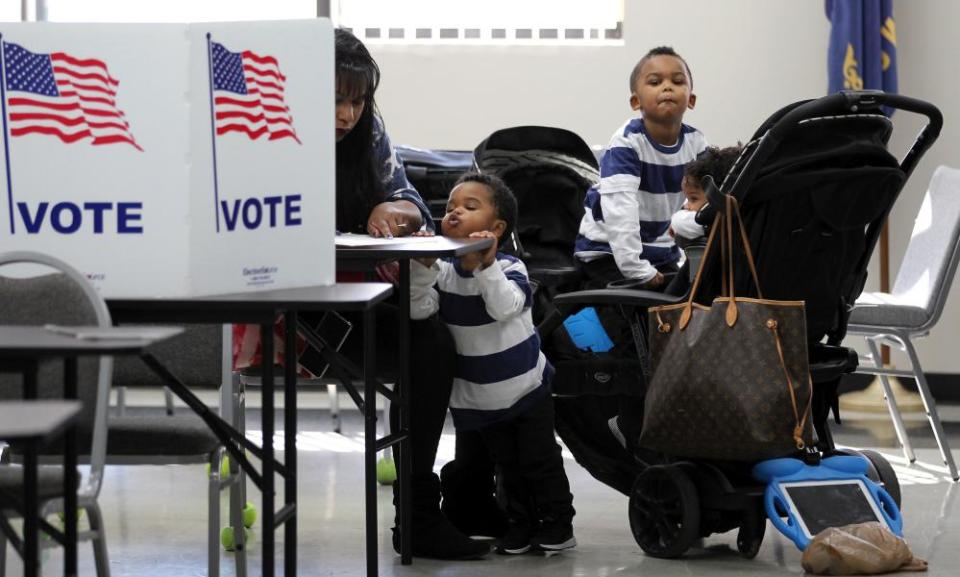Democrats make early midterm gains but 'blue wave' yet to materialize
Democrats pick up House seats in Virginia and Florida but Senate likely to remain in Republican control as Donnelly loses in Indiana

Democrats made a series of early gains as the first polls closed in the 2018 midterm elections, but uncertainty loomed over the prospect of a “blue wave” as the majority of House and Senate races were too close to call.
As initial returns trickled in from the midwest and east coast, Republicans remained competitive in key congressional and gubernatorial contests that mark a critical test for Donald Trump his administration. An energized American electorate is poised to deliver a verdict on the direction of the country under the president’s stewardship and whether Republicans should remain in power in Washington.
Democrats, who need to flip 23 seats to take control of the House of Representatives, picked up three seats previously held by Republicans.
In Virginia, Democrat Jennifer Wexton defeated Representative Barbara Comstock; and in Florida, the seat held by the retiring GOP representative Ileana Ros-Lehtinen went to Donna Shalala, a Democrat who formerly served as Bill Clinton’s health and human services secretary. Incumbent Republican Mike Coffman was ousted by Democrat Jason Crow in a Colorado district that swung for Hillary Clinton in 2016.
But the Democratic party’s chances of retaking the Senate appeared grim as Senator Joe Donnelly, a vulnerable incumbent Democrat, lost his seat to Republican Mike Braun. The Republican congresswoman Marsha Blackburn emerged victorious in Tennessee, a contest that drew national attention after pop star Taylor Swift endorsed the Democratic candidate, Phil Bredesen.
Democrats were, however, able to breathe a sigh of relief as Joe Manchin, another red state Democrat, held on to his Senate seat in West Virginia, a state Trump won by 42 points in 2016. Senator Bob Menendez of New Jersey and the Ohio senator Sherrod Brown, two other Democrats targeted by Republicans, were also re-elected to another term.
Democrats are defending 10 Senate seats in states that Trump largely won by double digits two years ago, rendering the upper chamber of Congress an uphill battle. Democrats had otherwise been favored to win back the House for the first time in more than a decade, but early results did not yet signal a rout was under way.
Healthcare and immigration were the top issues on voters’ minds as they cast their ballots, according to an exit poll survey conducted by the Associated Press, and 64% of those surveyed said Trump was a factor in their voting choice.
Higher than usual turnout was reported across the country, where 36 governor’s contests reinforced the ramifications of what former president Barack Obama dubbed as perhaps “the most important election of our lifetimes”.
Democrats are hoping to make gains at the state level and roll back a longstanding Republican advantage in governor’s mansions across the US. Wins for the party in battleground states such as Florida, Ohio and Wisconsin would not only lead to far more progressive state governments but also give the party influence in the redistricting process scheduled to take place after 2020.
At least two deep blue states voted to re-elect moderate Republican governors who succeeded by distancing themselves from Trump. Larry Hogan defeated Ben Jealous, the former chairman of the NAACP, in Maryland, while popular incumbent Charlie Baker resoundingly won in Massachusetts.
Democrats scored a pickup in Illinois, where JB Pritzker, whose family owns the Hyatt hotel chain, unseated the Republican governor, Bruce Rauner.
Democrats have sought to cast the 2018 midterms as a referendum on Trump, whose tenure in the White House has left Americans sharply polarized and been defined by a period of chaos, tribalism and the shattering of norms.
Trump’s divisive style was laid bare in the run-up to Tuesday’s election, which saw the president resort to unfounded claims about his political opponents and vitriolic rhetoric on immigration in an effort to energize his base in contrast to the positive economic message that many down-ballot Republicans were touting.
While crisscrossing the country on behalf of Republican candidates, Trump’s closing argument largely consisted of stoking fears around a caravan of migrants fleeing violence and poverty in Central America and headed toward the US-Mexico border. The president also repeatedly declared that Democrats, if elected, would lead a “socialist takeover” of America.
The elections carry significant ramifications for what remains of Trump’s first term.
If Chuck Schumer and Nancy Pelosi gain the majority, they will try to raise your taxes, restore job-killing regulations, shut down your coal mines and timber mills, take away your healthcare, impose socialism, and ERASE your borders. VOTE for @MattForMontana and @GregForMontana! pic.twitter.com/aDnCQKY7QD
— Donald J. Trump (@realDonaldTrump) November 3, 2018
Should they win back a majority in the House, Democrats are expected to launch a flurry of investigations into the president and his administration. The White House’s legal team is reportedly bracing for potential inquiries that include whether Trump obstructed justice in the Russia investigation, the misuse of taxpayer dollars by several cabinet officials, and hush money paid to women to keep silent about their alleged affairs with Trump before he was elected president.
A Democratic victory would also stonewall much of Trump’s agenda. Republicans have vowed to pursue further tax cuts and changes to popular government programs, such as Medicare, Medicaid and social security, and repeal and replace Barack Obama’s healthcare law, should they remain in power.
Although a number of Democratic heavyweights hit the trail to stump on behalf of candidates, including former president Barack Obama, former vice-president Joe Biden and former talkshow host Oprah Winfrey, the narrative was still dominated by Trump and his freewheeling rhetoric.
As he said at a rally on Indiana on Monday, “The midterm elections used to be like boring.
“Who ever heard of midterms?” he added. “Now it’s like the hottest thing.”
Additional reporting by Lauren Gambino

